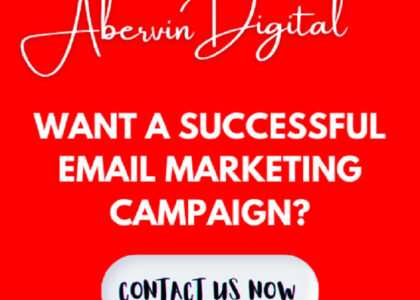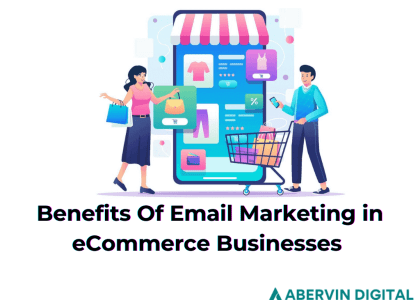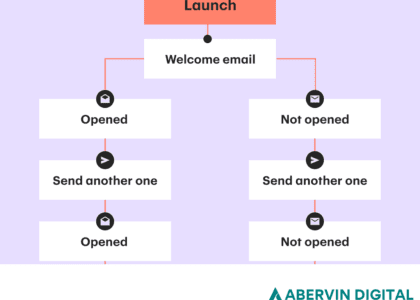One of the biggest questions we get at Abervin Digital is, “Do we really need to build an email list?”
To answer that, we’ll break it down with a common scenario – this should help it click!
You’ve spent years growing your following on Instagram, TikTok, X, or Facebook. You’re on fire – racking up followers, getting tons of engagement, and making sales. Life is good.
Then one day… BAM!
Your account is suddenly suspended without warning. Or maybe the algorithm shifts overnight, slashing your reach. The audience you spent years nurturing? Gone. Just like that.
Sounds dramatic? It’s happening every single day.
In 2025, businesses are losing access to their hard-earned followers due to account bans, algorithm updates, or even platform shutdowns. Remember Vine? Google+? MySpace? They were once social media giants – until they weren’t. Even Instagram and Facebook have seen organic reach plummet over the years. Brands that depended solely on these platforms saw their engagement – and revenue – take a nosedive.
It’s as devastating as a bad breakup.
Relying only on social media for marketing is like renting an apartment instead of owning a house. You’re living there, but the landlord (in this case, the platform) makes the rules. And if they decide to change things up, you have no say.
- Want to reach your followers? Better pay for ads.
- Got a viral post? Next week, the algorithm might bury your content.
- Accidentally violate a vague community guideline? Your account could be suspended indefinitely.
You’re not in control – and that’s a risky game to play with your business.
Why You Must Build an Email List for Business Growth
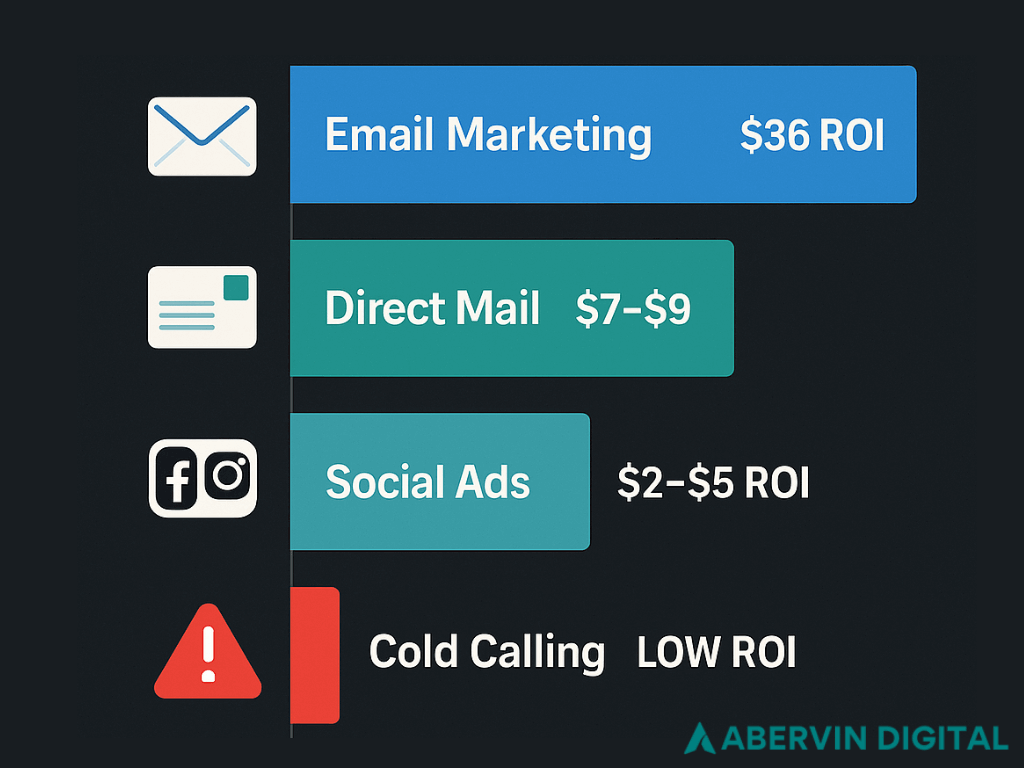
When you build an email list, you own your audience. No algorithm decides if your content gets seen. No platform can take your contacts away. You get a direct, reliable way to reach people whenever you want.
With email marketing, you:
- Own your audience: No third party decides who sees your content.
- Reach subscribers directly: No fighting algorithms or paying for visibility.
- Have better engagement: The average email open rate is 20-30%, while organic reach on social media is often less than 5% (and dropping).
- Get higher conversions: Email has an ROI of 36:1, meaning for every $1 spent, businesses make $36 back.
Plus, email isn’t going anywhere. Despite the rise of new platforms, studies show that 4.6 billion people will be using email by 2025. That’s over half the planet. A massive opportunity to grow your email subscribers and keep your business future-proof..
And if all that data just doesn’t do it for you, then maybe real world examples of business that blew up via emails would. Here are three brands that used email marketing to skyrocket their sales despite social media limitations:
1. Beardbrand: From YouTube to a $100M Business
Beardbrand, a men’s grooming company, thrived on YouTube and Instagram — until a 2016 algorithm change cut their video views by 60% overnight. Instead of panicking, they doubled down on building their email list, sending personalized campaigns and creating a loyalty program. They hit $100 million in sales, with email driving 50% of revenue.
2. Glossier: Email Drove 40% of Sales
Glossier, a beauty brand, blew up on Instagram but knew followers don’t equal revenue. They focused on email, sending exclusive product drops and personalized recommendations. Subscribers became 40% more likely to purchase, making email their #1 sales channel.
3. Cook Smarts: From SEO Dependence to 250K Email Subscribers
Cook Smarts, a meal-planning service, lived and died by Google rankings, until they launched lead magnets offering free recipes for email addresses. The result? 250,000+ subscribers, and sales that no algorithm update could touch. So now that you know why YOU REALLY need to build an email list? Let’s get into how you can build your email list.
How to Build An Email List FAST with Proven Strategies
Building a solid email list is hands-down one of the most powerful ways to grow your business. If you want to build an email list fast, you need the right tools and smart strategies. Let’s break down exactly how to make it happen quickly and effectively.
STEP 1: Pick the Best Email Platform to Build an Email List
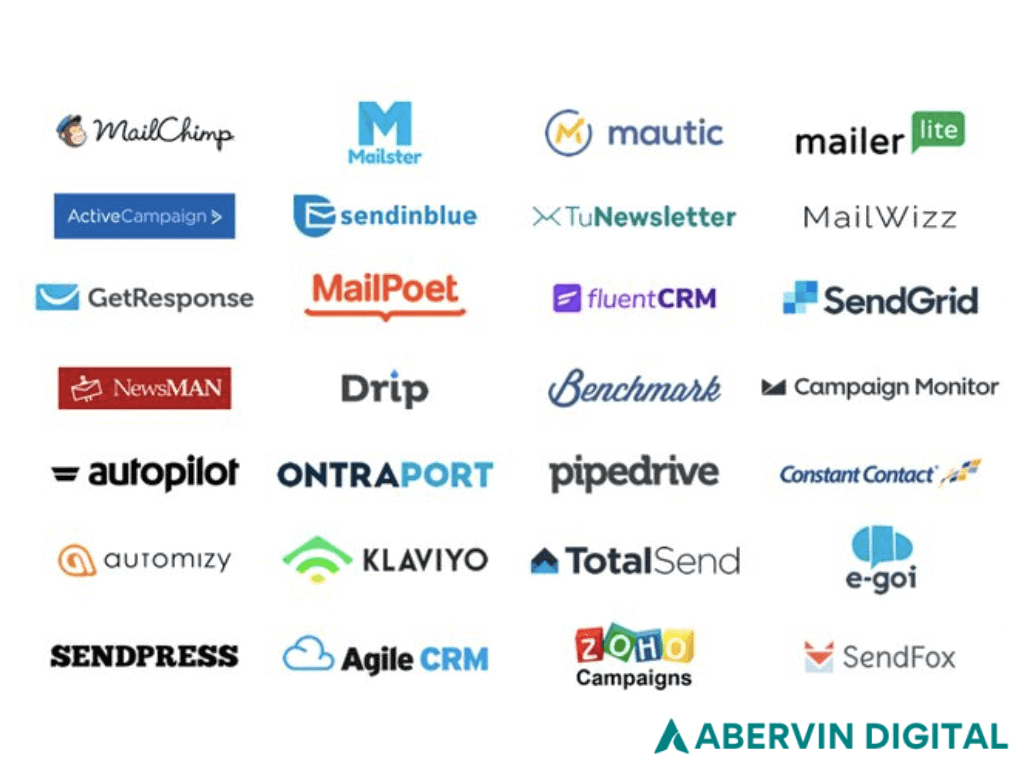
If you’re serious about email marketing and want to grow your email subscribers quickly, your platform choice matters There are a ton of Email Service Providers (ESPs) out there, but some are definitely better than others when it comes to features, scalability, and ease of use.
Platforms like Mailchimp, Klaviyo, and ActiveCampaign stand out with their easy-to-use features, automation, and segmentation tools. Mailchimp is great for beginners, while Klaviyo is perfect for eCommerce brands, and ActiveCampaign excels at automation.
Find one that fits your needs and offers the features that will help you scale quickly. And if you’re not sure what features to look out for, focus on features that’ll make or break your campaigns:
- Deliverability – Make sure your emails land in people’s inboxes and not their spam folders. Look for ESPs that have strong sender reputation scores and use authentication protocols like SPF, DKIM, and DMARC. Learn more about email deliverability best practices for 2025 here
- Automation – Set up automated sequences like welcome emails or reminders for abandoned carts. No need to do everything manually.
- Segmentation – Helps you break down your list based on how people behave, their interests, and demographics. This way, your emails feel more personal.
Now, if you’re in eCommerce and you’re wondering if investing in Klaviyo is worth it for your brand, our blog on Email Marketing for eCommerce in 2025: 8 Benefits For Brands has all you need to help you make the right choice for your business.
Once you’ve picked your ESP, read our 4 Must-Have Ecommerce Email Automations to 10X Your Online Store’s Revenue for high-impact workflows..
STEP 2: Create Lead Magnets That Convert

If you want to build an email list that’s full of engaged, ready-to-buy subscribers, you need to master lead magnets.
A lead magnet is simply a free offer you give in exchange for someone’s email. The deal’s simple: you give something valuable, they hand over their contact info, and boom…you’ve started a relationship that could lead to a sale.
Now let’s dive into some of the best lead magnets that hits your audience’s pain points, proves you know your stuff and helps you grow your email list:
eBooks & Guides: Show You Know Your Stuff
eBooks and guides are classic lead magnets because they give your audience a lot of info about a specific topic, making you look like an expert in your field. What’s cool about these is that they don’t just throw out random tips—they give real, actionable advice that people can actually use.
If you’re making an eBook or guide, think about what your audience is struggling with, and give them solutions. For example, if you’re a digital marketing pro, a free eBook titled “How to Run Your First Facebook Ad” would attract people who are totally lost when it comes to Facebook ads. The same concept applies across industries, like providing real estate email marketing strategies that offer value-driven guides for agents or brokerages. The key is to make sure it’s packed with real value – not just fluff.
Studies show that long-form content like guides or eBooks works because people see them as high-value. In fact, 72% of marketers say guides and eBooks help with lead generation. So, if you make something that’s well-researched, easy to follow, and gives solid solutions, you’re golden.
Discounts & Special Offers: Everyone Loves a Deal
If you run an online store, discounts and exclusive offers are a no-brainer. Offering a limited-time discount is a proven way to grow your email subscribers while also driving sales.
This works really well if your audience is big on getting the best price. Let’s say you’re a clothing brand offering a 20% off coupon for new subscribers is a no-brainer. Or, you could offer exclusive access to member-only sales. This creates that sense of FOMO (fear of missing out) and makes people more likely to sign up.
Plus, exclusive offers don’t just bring in sales—they help build trust and loyalty. Studies show that 56% of consumers are more likely to make a purchase if they’ve received a special offer. The secret? Make your deals time-sensitive to get people to act faster.
Templates & Swipe Files
Templates and swipe files are perfect if you want email list building strategies that save your audience time. Swipe files are collections of proven copy or ideas people can adapt. Templates are ready-to-use outlines for emails, social posts, or blog articles.
The cool thing about these is that people don’t have to create stuff from scratch. For example, if you offer a set of email templates for someone to use in their own campaigns, they don’t have to start from square one. Or, if you run a content marketing agency, giving away a content calendar template helps people plan out their social media posts.
People love templates because they make life easier. 56% of consumers say they’re more likely to give up their email if they get a helpful resource like a template or swipe file. These are especially effective in industries where time is money—like marketing or content creation.
Quizzes & Assessments: Make It Fun & Personalized
Want to really engage your audience? Try quizzes and assessments. These interactive lead magnets are a great way to gather emails, but they also give your audience personalized results based on their responses. And who doesn’t love seeing what they “get” at the end of a quiz?
For example, if you run a fitness brand, you could offer a “What’s Your Fitness Personality?” quiz. Or if you sell skincare products, a “Find Your Ideal Skincare Routine” quiz would be perfect. You get emails, and they get tailored recommendations. It’s a win for everyone.
Quizzes and assessments are proven to work—they tend to have higher conversion rates than other lead magnets. Interactive content can boost lead generation by as much as 35%. Plus, quizzes are fun and people like doing them, so they’re way more likely to take the time to give you their email.
The best way to build an email list is to give your audience something they can’t resist…something valuable, relevant, and genuinely helpful. Whether it’s an eBook, a discount, a template, or a quiz, the goal is the same: solve their problem and make it easy for them to say “Yes, I’ll sign up for that.”
STEP 3: Build a Landing Page That Actually Gets People to Sign Up
Your landing page can make or break your ability to build an email list. Think of it like a first date: if it’s boring, confusing, or trying too hard, people bounce…fast. But if you nail it? Boom. You’ve got their attention, their trust, and maybe even their email.
A great landing page isn’t just about looking pretty. It needs to grab attention, make your offer crystal clear, and guide visitors to take action without making them overthink it. Let’s break it down.
Hit ‘Em With a Clear, No-Nonsense Value Proposition
Before someone even thinks about signing up, they need to know one thing: What’s in it for them?
If you want to make your offer pop, you have to be specific. Instead of “The best fitness app ever”, say “Lose 10 pounds in 30 days with our AI-powered workout planner.”
You’ve got to keep it about them because honestly, people don’t care about your brand; they care about how you help them, so make your value proposition all about solving their needs.
Don’t try to be too clever in your value proposition because prospects will already be out the door if it takes effort to understand your offer. Keep it short, clear, and benefit-driven.
Write a Headline That Stops the Scroll
You’ve got three seconds to convince people to stay. Your headline needs to slap. Lead with a benefit. Instead of “We Help Startups Grow”, say “Get Your First 1,000 Customers in 60 Days.”
Keep it short because anything longer than 6–12 words, max, people start tuning out.
Use numbers or proof because stats make your claim feel more real. Example: “Marketers Who Use This Tool See 300% ROI.”
Keep It Simple, Less is More
The more you ask for upfront, the more people hesitate. So what you want to do is keep your sign-up forms simple by only asking for the essentials. Name and email? Cool. Asking for their dog’s birthday? Overkill.
You also want to use Autofill where possible because if their browser can pre-fill info, and give you their details in simple clicks…use it. In fact, we recommend a one-click sign-up like Google or Facebook login which means prospects have less friction during sign-ups which by extension means more sign ups.
Keep It Clean & Easy to Skim
A cluttered landing page is like a messy room – it stresses people out. Your goal is to have clear, simple, and distraction-free landing pages.
Minimal distractions, zero random pop-ups or flashy animations and a true focus on your message are some of the things that make a Landing Page look good.
As much as you want to provide as much information as you have on your landing page, leaving some white space between your content gives your content room to breathe so people don’t feel overwhelmed reading long-form content.
You can make key info stand out in your content when you use bold text, bullet points, and clear sections to guide the reader’s eye.
Your Call-to-Action (CTA) Needs to Be Unmissable
Your CTA button is what turns visitors into leads or customers. This is the money-maker so you want to make it pop because if your button is boring or easy to ignore, people will scroll right past it.
One way to make people click is to use words that nudge people so instead of something dull like “Submit”, go for “Get My Free Guide” or “Start My Trial” – something that tells them exactly what they’re getting. Another smart CTA button trick is to create a sense of urgency.
When people feel like they might miss out, they’re more likely to act fast. Try adding phrases like “Limited Spots Available” or “Offer Ends Soon” to nudge them in the right direction.
Finally, your CTA button should stand out, not blend in so you want to pick a color that contrasts with the rest of your page.
Test Everything (Seriously, Everything)
Guesswork is dumb! A great landing page is not built overnight – it has to be tweaked and improved over time. What you think works might not be what actually gets people to click. That’s why A/B testing is a must. You can test your headlines by trying different wording to see what which one hooks people better.
For your form length, fewer fields usually lead to more signups, but we also recommend testing to find the sweet spot. And no matter how good you are at designing, figuring out if your CTA placement works better at the top or bottom is something only testing can tell.
Sometimes, your content will convert better with no images, Image A or Image B. We recommend testing different images, colors, or even removing certain elements to see what converts best..
The point is only testing really helps you find what works for you.
Show People They Can Trust You
Nobody likes feeling scammed. Build trust fast with testimonials, reviews, case studies, and recognizable brand logos.
If you’ve been featured somewhere legit, show it off. Use before-and-after stories and real stats to prove your offer delivers. The more proof you stack, the easier it is to build an email list that actually converts.
A high-converting landing page isn’t magic – it’s just smart design, clear messaging, and a friction-free experience. By choosing the right ESP, creating irresistible lead magnets, designing user-friendly landing pages, and implementing STEP 4, you can build your list fast and set your business up for success.
Let’s dive into it.
STEP 4: Reach Prospects And Turn Them into Subscribers: Proven Strategies to Grow Your Email List
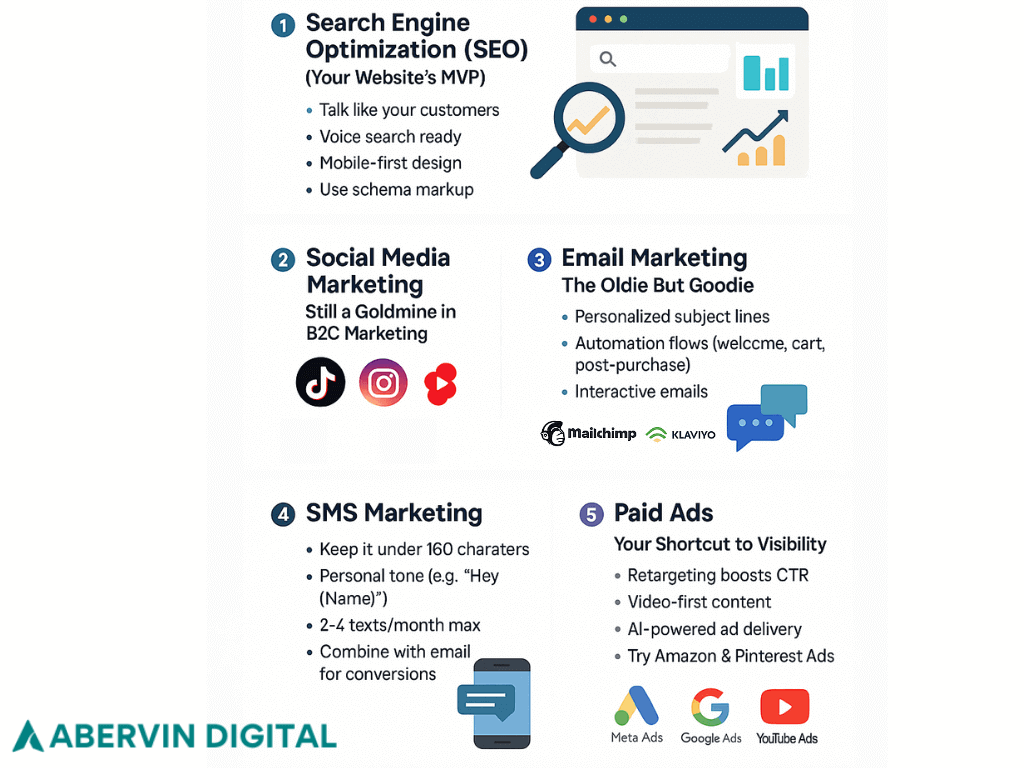
If you want to build an email list, you can’t just slap a “Subscribe Now” button on your site and hope for the best. The goal isn’t a random pile of addresses. It’s about getting people who actually want to hear from you. Whether you’re going for slow and steady organic growth or want to speed things up with paid strategies, the key is knowing what works and sticking with it. Let’s talk about some of the best ways to get more sign-ups without annoying people.
Because yeah, there is a way to get it – mildly annoying a few people. Haha! No Kidding. Cold Emailing is one way but we’ll get into that in another blog. For now, let’s talk about the best ways to get more subscribers, whether you’re playing the long game (organic growth) or using paid strategies to speed things up.
Growing Your List Organically (AKA The Sustainable Way) – Blogging, YouTube, and SEO
Creating valuable content is a long-term strategy that establishes trust and naturally drives users toward your email list. Nobody’s giving up their email for boring, generic content so you need to give them something worth subscribing for. Something that makes them willingly exchange their email addresses – and want to be “happily bothered” by your content.
Blogging for Lead Generation
If you’re already writing blog content, add a little extra oomph by including a freebie (like a checklist or mini-guide) that readers can get in exchange for their email. Here are a few tips to do blogging the right way.
- Find out what topics people are interested in by checking search trends.
- Create long-form, value-driven content that naturally leads to an email opt-in.
- Use embedded sign-up forms within your blog posts to capture interest at peak engagement points.
YouTube as an Email Capture Channel
If you’re making videos, don’t forget to plug your email list! Drop in a quick call-to-action, like (“Want to see more like this? Sign up for my free email series!”) in your video and description. By providing insightful content and strategically placing calls-to-action (CTAs), you can funnel viewers into your email list. Here are some tips to make your YouTube an effective Email capture channel.
- Include a compelling lead magnet in the video description and pinned comments.
- Use end screens and verbal prompts to encourage viewers to subscribe to your email list.
- Host live Q&A sessions with exclusive follow-up content available only via email.
Search Engine Optimization (SEO) for Sustainable Growth
SEO-driven content ensures that your resources continue to attract organic traffic over time. Write about what people are already searching for. If you show up in their Google results with exactly what they need, they’ll be way more likely to hit that subscribe button.
- Using long-tail keywords attract highly targeted traffic that’s more likely to convert.
- Make sure your headlines and meta descriptions match what people are actually searching for. Keep them clear, relevant, and catchy so they grab attention.
- Link your content together in a way that naturally leads readers to sign-up pages or exclusive content.
Using Social Media to Turn Followers into Subscribers
Social media is great for engagement and provide a direct line to potential subscribers, but followers come and go. Here’s how to turn them into long-term subscribers:
- Instagram & Facebook Polls, Quizzes, and Giveaways – People love interactive content! Try running a giveaway where entry requires an email sign-up, or create a quiz where they get their results via email.
- LinkedIn Thought Leadership – If you’re in the B2B world, post deep-dive content on LinkedIn and offer a free email-exclusive resource at the end.
- Tweet Threads with Value – Break down an interesting topic in a Twitter/X thread and direct readers to your newsletter for an even deeper dive.
Guest Posts and Strategic Collaborations with Others to Expand Your Reach
Partnering with other content creators or brands can expose your business to new audiences. Why grow your email list alone when you can team up with other creators and brands?
- Cross-Promotions – Partner with brands targeting similar audiences and offer exclusive email-only content or discounts to their subscribers in exchange for promoting your list.
- Guest Blogging – Writing guest articles for high-traffic industry blogs allows you to include lead magnets within your author bio or in-content links. Reach out to established blogs, provide valuable content and sneak in a lead magnet (like a free guide) that links to your email sign-up.
- Co-Hosted Webinars & Live Events – Partner with an influencer or brand in your niche and require email sign-ups to attend.
Using Paid Strategies to Grow Your List Faster
Organic growth is awesome, but sometimes you want to build an email list at lightning speed. While organic methods create steady, sustainable growth, paid strategies let you target the right people at scale and grow your email subscribers much faster.
This is where ads and paid partnerships come in. Here’s how to make them work for you.
Facebook & Instagram Lead Ads
Meta’s lead generation ads allow users to sign up without leaving the platform, reducing friction and increasing conversions. Here are some of the smartest ways to use Facebook and Instagram Ads to build your list:
- Make your content stand out with scroll-stopping visuals and messaging that pulls people in.
- Offer an immediate incentive, such as a free checklist, webinar access, free trial, downloadable resource, or discount.
- Find more people who vibe with your brand by using lookalike audiences to find prospects that share the same interests as your current customers.
- Implement follow-up email sequences to nurture leads after they opt in.
- Test ad creatives and formats (carousel, video, static images) to determine what resonates best.
Google Ads: Capturing Intent-Driven Traffic
The interesting thing about Google Ads is it puts you in front of people already searching for what you offer. Unlike social media, where ads target interests and behaviors, Google Ads focus on intent—users actively searching for solutions. Capturing these email addresses through search campaigns requires strategic planning.
- Search Ads with Lead Magnets: Run ads targeting specific problem-solving queries (e.g., “best email marketing strategies”) and directing users to a dedicated landing page with an email opt-in.
- YouTube Retargeting Ads – Show video ads to people who’ve already visited your site, promoting your free email series or guide.
- Display Network Ads with Contextual Targeting: You can retarget previous visitors with display ads to encourage visitors to subscribe by placing banner ads on industry-relevant sites .
Influencer Partnerships for Email List Growth
Influencers already have an engaged audience and working with those in your niche can drive high-quality subscribers who are genuinely interested in your content to your email list. Some of our favorite influencer partnership strategies include:
- Giveaways and Contests: Running influencer-hosted giveaways where entry requires an email subscription, ensuring high participation rates.
- Sponsored Email Campaigns: Partnering with influencers to send exclusive content or offers directly to their subscribers.
- Instagram Story & Reel Promotions: Have influencers shout out your freebie in a short, engaging video with a direct sign-up link.
The most effective email list growth strategy combines both organic and paid methods. Try different strategies and see what works for your audience. Organic methods build long-term trust, while paid ads and partnerships help you scale faster. The key is to make signing up feel like a no-brainer – give people a reason to join, and they will.
Build an Email List the Right Way: Best Practices for Long-Term Success
If you want your email marketing to actually work (and not get you in trouble), you need to build an email list the smart way. Think of it like planting a garden. You pick the right seeds, water them regularly, and keep the weeds out. Do this right, and you’ll have a thriving, engaged audience that drives sales and keeps coming back.
Here are the email list building strategies you can use to keep your list healthy and growing.
1. Stay Compliant with Email Marketing Laws
Imagine showing up to a party at Ed Sheeran’s house without asking. Crazy… right? In the same way, you need permission to send emails to people. This is where laws like CAN-SPAM (US), CASL (Canada), and GDPR (EU) come in. These laws make sure you’re not sending emails to people who don’t want them. Here’s how to stay compliant:
- Get permission first: Make sure people sign up for your emails willingly. Don’t add people to your list without their consent.
- Easy opt-out: If someone doesn’t want to hear from you anymore, they should be able to leave easily. Always include a clear “unsubscribe” option at the bottom of your emails.
- Use double opt-in: After someone signs up, send a confirmation email to make sure they really want in. This is like getting a “yes” to an invitation twice—first, when they sign up, and again when they confirm.
2. Never Buy Email Lists
Buying email lists might seem like a shortcut, but it’s like buying a car without checking the engine. Sure, you get a list, but it’s likely full of people who don’t care about your business or even worse, might mark you as spam. Here’s why you don’t want to buy an email list:
- It’s illegal and unethical: Sending emails to people who didn’t ask for them can get you in legal trouble.
- Bad engagement: The people on a purchased list don’t know you or your business. It’s like inviting strangers to your party—they’re less likely to be interested, and more likely to leave early (or mark your emails as spam).
3. Clean Your List Regularly
Think of your email list like a garden that needs regular weeding. Over time, some people will stop engaging with your emails or change their email addresses. If you keep sending emails to these inactive contacts, you risk getting flagged as spam.
- Remove inactive subscribers: If someone hasn’t opened your emails in six months or more, consider removing them from your list or sending a “win-back” email asking if they’re still interested.
- Win-back campaigns: Before removing inactive subscribers, send them an email to re-engage. It’s like checking in with an old friend to see if they still want to hang out. If they don’t respond, it’s time to part ways.
4. Segment Your Audience
Not all your subscribers are the same, so why send them the same message? Segmenting your audience is like giving different types of party guests what they enjoy… some like pizza, some like burgers. Make sure your content fits what each group likes:
- Behavior-based segmentation: Group subscribers based on what they do. For example, you could create segments for people who have made a purchase vs. those who haven’t yet. You can also track when each group tends to engage most and use that data to determine the best time to send emails to each segment.
- Demographic-based segmentation: If you know a bit more about your subscribers (like age, location, or interests), use that information to send emails that speak to their specific needs and land at just the right moment.
5. Send Relevant Content
Your emails should feel valuable to the recipient. If you keep sending generic, irrelevant emails, people will stop opening them. This is like inviting someone to a party that has nothing they enjoy—they’ll stop coming.
- Personalize your emails: Use the data you’ve gathered (like their name, interests, or past purchases) to make the content feel more personal. Even small touches, like greeting someone by name, can make a big difference.
- Offer real value: Give your subscribers something they actually care about—whether it’s a helpful tip, a special discount, or early access to a new product.
6. Test and Improve
Think of it like perfecting a recipe—you have to taste and tweak to get the best results. Regularly testing different elements of your emails can help improve performance:
Track key metrics: Keep an eye on open rates, click-through rates, and conversion rates to measure success and make adjustments.
A/B testing: Test one variable at a time (like subject lines, images, or call-to-action buttons) to see what your audience responds to best.
To build an email list that works for you long-term, focus on trust, relevance, and value. Follow these email list building strategies, and you’ll grow your email subscribers naturally
For more advanced email marketing strategies, or to get started building your list, contact Abervin Digital at +1 (720) 583-5547 or visit Abervin Digital.




